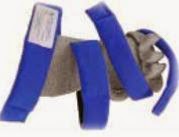 |
| Dr. Scott Rand |
What led you to a career in sports medicine?
I played sports in high school, but was not really an athlete. During college and medical school, sports and exercise were just not part of what I did, but when I joined the Navy for my residency, I became attached to an active population of people. My residency was basically taking care of healthy people who hurt themselves, so the move to sports medicine was a natural fit. I enjoy taking care of people who take responsibility for their health and want to make themselves better.
What do you think is the biggest misconception about sports injuries?
Most of us think of sports injuries as the things that make the highlight reel for ESPN. Many more training days and competition days are missed because of overuse injuries and medical illnesses.
Injuries to the knee, especially the ligaments, seem to be incredibly prominent these days. Do you think this is the result of poor conditioning, tougher play, better medical care to diagnose a knee injury properly, or something else?
I don’t think knee injuries are that much more common now than they were 20 years ago. Since we have better technology and techniques for treating these injuries, they get more attention. Athletes are certainly bigger and stronger now, but I think the increased awareness comes from a larger number of athletes participating and a greater awareness because of the treatments we now have to treat these injuries, both surgically and non-surgically.
What is the most common sports-related injury you encounter in your work?
Right now, concussions are Number 1. We see athletes of all ages for all kinds of problems. During football and club soccer season, concussions are our leading injury. Injuries happen in collision sports. That is a given. Many positive things also come from participation, however, so I think that overall the benefits outweigh the risks.
What is the most common thing you see athletes do incorrectly when rehabbing from an injury?
Easy. Too much, too fast, too soon. We are always in search of the magic bullet or high tech procedure that will allow quicker return to play. Getting back on the field is the most important thing and anything that will speed that along is the right thing to do. That is a lie and is probably what is the most dangerous thing for athletes to look for.
When is surgery the wrong route to take for recovery from an injury?
When pain is the major factor. Orthopedic surgery can restore function pretty well, but when the driving issue is pain, surgery is often not the best solution. Pain may not go away, even if function improves.
Do you think physical therapy is being utilized by patients as much as it should?
Physical therapy has huge benefits for people, but unfortunately the outcome-based and evidence-based studies have not borne it out. Physical therapy fails when patients are not compliant with the exercise plan put forth by the physical therapist. PT that doesn’t make you sweat or cry wasn’t worth going to.
In your opinion, what is one of the biggest changes to sports medicine in the last few years?
The therapeutic modality that is getting the most attention right now is regenerative medicine. The promise of healing with your own tissue by simply injecting platelet-rich plasma or bone marrow or fat cell derived stem cells is very exciting. Right now the science is equivocal, but the potential for amazing things is there and will hopefully be made readily available.
What is the most rewarding aspect of working in sports medicine?
Taking care of people who have to be held back rather than pushed off the couch. Watching an athlete recover from a devastating acute or chronic injury and return to compete at a higher level than they ever could before.
If you could impart any words of wisdom on young coaches or athletes, what would they be?
Be alert and cognizant when something looks or feels wrong. Then stop. It sounds simple, but personal health is so often overlooked for the sake of the win. When it comes to your overall health, you’re in a marathon, not a sprint.
Dr. Rand is a graduate of the University of South Dakota School of Medicine, and is a board certified physician of family medicine with a certificate of added qualification in sports medicine (CAQSM). He is the director of the Primary Care Sports Medicine Fellowship program at Houston Methodist Willowbrook, one of only 111 accredited programs in the country. Additionally, he is the medical director of the Houston Methodist Human Performance Lab. His practice maintains a focus around overall medical care, concussion management, and non-operative orthopedic care of athletes and active people of all ages. Dr. Rand co-chairs an education testing subcommittee within the American Medical Society for Sports Medicine, guest speaks regularly, is a co-author and editor of the AMSSM’s Sports Medicine CAQ Study Guide, and is an assistant professor at Weill Cornell Medical College. Dr. Rand regularly serves as a consulting team physician for Houston-area high schools, club sports, running groups, and Rice University.

































